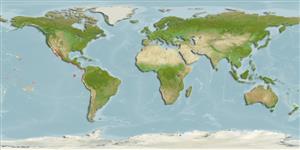>
Eupercaria/misc (Various families in series Eupercaria) >
Gerreidae (Mojarras)
Etymology: Gerres: Latin, gerres = a kind of anchovies; cited by Plinius.
Environment: milieu / climate zone / depth range / distribution range
Ecologia
marino; salmastro associati a barriera corallina; distribuzione batimetrica 0 - 30 m (Ref. 93032). Tropical
Eastern Pacific: Mexico (southern Baja and the lower Gulf of California) to Peru, and the Galapagos.
Size / Peso / Age
Maturity: Lm ? range ? - ? cm
Max length : 41.0 cm TL maschio/sesso non determinato; (Ref. 93032)
Short description
Chiavi di identificazione | Morfologia | Morfometria
Spine dorsali (totale) : 9; Raggi dorsali molli (totale) : 10; Spine anali: 2; Raggi anali molli: 7. Body color silvery white with about 8 faint dark bars on side, pelvic and anal fins are yellowish; body deep (depth 2.3-2.7 in SL); highly extensible mouth, pointing downward when protruded; lower border of preopercle is smooth, bone under front of eye with smooth border; D IX,10; A II,7; large scales conspicuous and finely rough, covering most of the head and body; 39-44 lateral line scales (Ref. 93032).
Inhabits sand bottoms adjacent to reefs and also entering brackish estuaries (Ref. 93032). Feeds on insects (Ref. 93032).
Life cycle and mating behavior
Maturities | Riproduzione | Spawnings | Egg(s) | Fecundities | Larve
Robertson, D.R., 2013. Shorefishes or the tropical eastern Pacific online information system: Fishes. Smithsonian Tropical Research Institute. http://biogeodb.stri.si.edu/sftep/taxon.php [Accessed 25/02/2013]. (Ref. 93032)
IUCN Red List Status (Ref. 130435)
Threat to humans
Harmless
Human uses
Strumenti
Special reports
Download XML
Fonti Internet
Estimates based on models
Preferred temperature (Ref.
123201): 22.3 - 29, mean 26.4 °C (based on 231 cells).
Phylogenetic diversity index (Ref.
82804): PD
50 = 0.5000 [Uniqueness, from 0.5 = low to 2.0 = high].
Bayesian length-weight: a=0.01259 (0.00669 - 0.02368), b=3.04 (2.88 - 3.20), in cm total length, based on LWR estimates for this species & Genus-body shape (Ref.
93245).
Trophic level (Ref.
69278): 3.4 ±0.3 se; based on size and trophs of closest relatives
Resilienza (Ref.
120179): Medio, tempo minimo di raddoppiamento della popolazione 1.4 - 4.4 anni (Preliminary K or Fecundity.).
Fishing Vulnerability (Ref.
59153): Low to moderate vulnerability (31 of 100).
